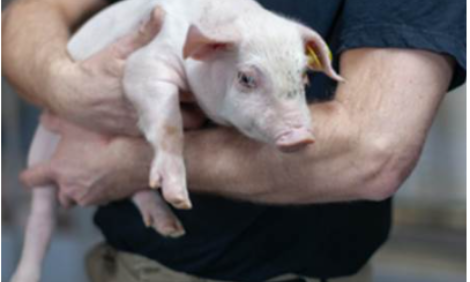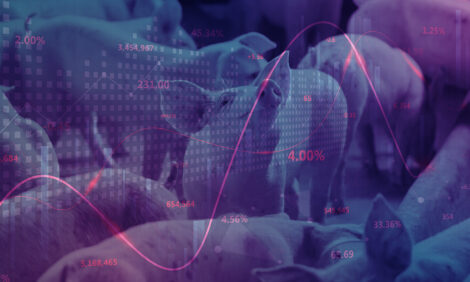



Competition from South American Pork Production
By Luciano Roppa and presented at the 2005 Banff Pork Seminar - The ongoing growth of the world population has made researchers ask where food will be produced in the future. What areas will have land and water availability for food production based on plant and animal proteins? |
Introduction
Which foods can be produced on a large scale in order to satisfy the needs of the world population and, particularly, the current 800 million of destitute people? This article aims at analyzing the present situation of pork production in the world, its growth perspectives, its capacity to contribute to the production of animal protein of a high biological value, and the role of South America in face of the challenge of the increasing world hunger.
The Swine Industry in the World Today
In 2003, pig producers around the world produced 98.5 million tons of pork,
with a herd of approximately 1 billion animals. Asia was the largest producer
(55% of the world production), with 54.4 million tons. The European continent
was in second place, with 26% of the production (25.9 million tons). The
Americas followed with 17 % (16.7 million tons), Africa with 0.78% (0.77 million
tons), and Oceania with 0.56% (0.55 million tons)(Table 1).
Table 1: Pork world production per continent, 2004  |
Main World Producers
China is, by far, the largest producer of pork, with 46 million tons of production
accounting for 46.7% of total production in the world. China is also the largest
individual consumer in terms of quantity, as most of its production is consumed
by its population of more than 1.3 billion inhabitants. As can be seen in Table 2,
the 10 largest producing countries in 2003 deliver 87.3 % of world production.
Together, they produced 86 million tons of pork. Brazil is the only South-
American country among the 10 largest producers of pork.
Table 2: Main world producers of pork (million tons, 2003)  |
World Pig Meat Consumption
If we divide the world production of pork (98.5 tons) by the population in the
planet (estimated at 6.3 billion people in the beginning of this year), we can
conclude that consumption was around 15.6 kg per capita. This number is very
impressive, putting pork as the first preference of people globally, with the title
of “the most consumed meat in the world”.
In fact, pork has occupied this position since 1976, when it first exceeded beef.
In 2003, as can be seen in Table 3, chicken consumption was in the second
place, with 10.31 kg, and beef was third, with 9.34 kg per capita.
Table 3: World pig meat production and consumption, 2003  |
Chicken reached second place, exceeding beef, only in 1996. Its consumption
has grown at a higher rate than pork consumption, but it is not expected that
chicken will surpass pork, at least in this decade, due to the growth of the
economy in China, a country which traditionally prefers foods based on pork.
Is the consumption of pork stable or has it grown lately? In the last 14 years
(1990 to 2003), pork consumption by the world population has grown at a rate
of 1.3% a year. (Table 4)
Table 4: Evolution of the world consumption of pork, 1970-2003  |
What will be the World Production of Pork in 2015?
According to FAO, the world population will be 7.28 billion in 2015. There are
two procedures to estimate the production of pork by 2010. The first assumes
that the consumption per capita will remain the same (15.62 kg), and the
second, that consumption will keep on growing 1.3% a year. In the second
case, pork consumption per capita will be 18 kg in 2015.
We may consider that the first possibility is pessimistic, and the second,
optimistic. If we multiply both perspectives by the population in 2015 (7.28
billion people), the conclusion is that the world production of pork to meet
estimated demands will be between 113 million tons (pessimistic) and 130
million tons (optimistic).
Where will Swine Production Grow in the World?
If we need to increase world production by 30 million tons in the next 11 years
in order to provide for the population growth and to reduce hunger, where are
the most appropriate places with the right conditions to achieve this increase in
production?
A document called “Agriculture towards 2010” by FAO tries to answer this
disquieting question through well grounded statistics, which evaluated the
current trend based on the history of the last few years. This study shows that.
in 1978, 60% of pork was produced by developed countries, and that only 40%
by the developing countries. However, this percentage has changed
dramatically in the last few years, as there has been a higher rate of increase of
pork production in the developing countries. The conclusions of this FAO report
is that, in 2010, the situation will be the opposite from what it was in 1978, and
that 60% of the world pork will be produced in developing countries. Table 5
shows this clear trend, based on data of the last years.
Table 5: World pork production in developed and developing countries (million tons, 1995-2003)  (Source: L. Roppa. 2004) |
In the last 8 years (1995-2003), world production of pork grew 25 % (from 78.88 to 98.50 million tons). If we analyze this growth in the greatest world producers, we will see that it increased 38.7% in China. 12.3% in the EU-15 (European Union). 11.9% in the USA. 53.1% in Canada and 83.5% in Brazil. China and Brazil, due to their continental dimensions and grain production capacity. are prominent among the group of Developing countries.
Key Conditions for Pork Production in the Future
There are many essential conditions for a country which aims at being a big
pork producer in the future. If we had to stress only four, we would choose the
following: environment preservation. concern with animal welfare. water
availability (for drinking and grain production), and land availability to store
waste and to produce basic grains for swine feeding.
The first two conditions are cultural and fortunately are already accepted as
essential standards in some regions of the world, especially in Europe. The
trend is to increase the adoption of these practices because it is a fair demand
by the consumers themselves. Environmental preservation is a basic need to
our own survival, making this requirement unquestionable. As to the other two
conditions (water and land availability), some comments, which may be critical
to the growth of production is some areas of the world, must be made.
Water: Our planet consists of 71% water and 29% land. However. 97.24% of
the water is saline (oceans) and cannot be drunk by man or animals. as it is.
Fresh water represents just 2.76% of the remaining water in the planet.
However, not all of it is available, as 2.14% is in bound form in the glaciers.
What is left, and this is not much, is water stored in underground aquifers
(0.61%). and in rivers. lakes. moisture in the soil and in the atmosphere
(0.01%). There are a few countries which have the privilege of having abundant
fresh water. Today, about 1 billion people have no access to potable water, and
11.000 children die everyday around the world due to problems related to the
lack of water or its bad quality. Thus, water availability is an essential and
limiting factor to pig production. Regions with higher water availability have
better conditions for producing, not only swine, but also other raw materials
(grains) essential to their feeding.
Land: One of the greatest limitations for the growth of swine production is
waste. A pig defecates the equivalent of 2.5 people, and the use or storage of
this waste is becoming a serious problem in large farms. One way of using this
waste is as fertilizer. Therefore, countries with large areas of land and adequate
climate will have the advantage of using the waste as fertilizer in crops and of
producing grains for feeding the pigs at a lower cost. When we look around our
planet for available areas for grain crops, we can see that there are just a few,
and are decreasing every year. The sweeping forest destruction and fires have
accelerated the process of desertification. According to the Times World Atlas
(1996 edition) this is alarming in Africa and Australia. as 75 and 65% of their
land, respectively, suffer this problem. The continents with lower desertification
are Europe (29%). North America (29%) and South America (31%).
Further Information
To continue reading this article, including graphs click here
To view the full Banff Pork Listing, click here
Source: Paper presented during the 2005 Banff Pork Seminar Procedings









